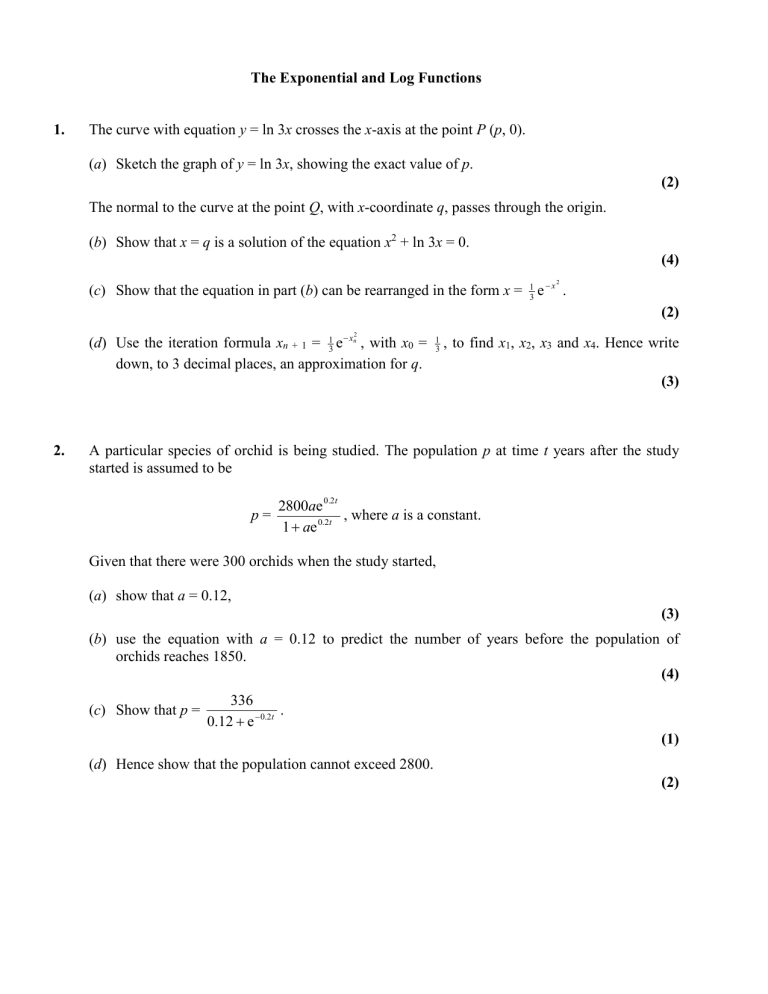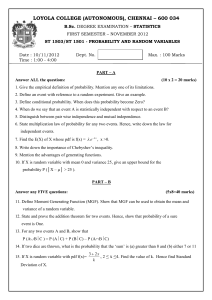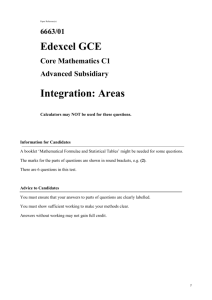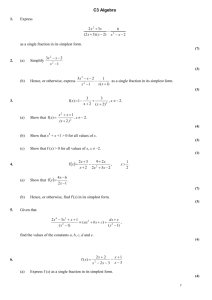The Exponential and Log Functions with answers.
advertisement

The Exponential and Log Functions
1.
The curve with equation y = ln 3x crosses the x-axis at the point P (p, 0).
(a) Sketch the graph of y = ln 3x, showing the exact value of p.
(2)
The normal to the curve at the point Q, with x-coordinate q, passes through the origin.
(b) Show that x = q is a solution of the equation x2 + ln 3x = 0.
(4)
(c) Show that the equation in part (b) can be rearranged in the form x = 13 e x .
2
(2)
(d) Use the iteration formula xn + 1 = 13 e xn , with x0 =
down, to 3 decimal places, an approximation for q.
2
1
3
, to find x1, x2, x3 and x4. Hence write
(3)
2.
A particular species of orchid is being studied. The population p at time t years after the study
started is assumed to be
p=
2800ae 0.2t
, where a is a constant.
1 ae 0.2t
Given that there were 300 orchids when the study started,
(a) show that a = 0.12,
(3)
(b) use the equation with a = 0.12 to predict the number of years before the population of
orchids reaches 1850.
(4)
(c) Show that p =
336
.
0.12 e 0.2t
(1)
(d) Hence show that the population cannot exceed 2800.
(2)
3.
The functions f and g are defined by
f : x 2x + ln 2,
x ℝ,
g : x e2x,
x ℝ.
(a) Prove that the composite function gf is
x ℝ.
gf : x 4e4x,
(4)
(b) Sketch the curve with equation y = gf(x), and show the coordinates of the point where the
curve cuts the y-axis.
(1)
(c) Write down the range of gf.
(1)
(d) Find the value of x for which
d
[gf(x)] = 3, giving your answer to 3 significant figures.
dx
(4)
4.
A heated metal ball is dropped into a liquid. As the ball cools, its temperature, T C, t minutes
after it enters the liquid, is given by
T = 400e–0.05t + 25,
t 0.
(a) Find the temperature of the ball as it enters the liquid.
(1)
(b) Find the value of t for which T = 300, giving your answer to 3 significant figures.
(4)
(c) Find the rate at which the temperature of the ball is decreasing at the instant when t = 50.
Give your answer in C per minute to 3 significant figures.
(3)
(d) From the equation for temperature T in terms of t, given above, explain why the temperature
of the ball can never fall to 20 C.
(1)
N23494A
2
Turn over
5.
The population of a certain country was 50 million at the start of 2000.
At the start of the year 2000 + t, it is estimated that the population will be
k
2 3e t / 40
million.
(a) Find the value of k.
(2)
(b) Use the given formula to estimate
(i) the population at the start of 2010,
(3)
(ii) the year in which the population will be 100 million.
(3)
(c) Show that, according to this model, the population can never exceed 125 million.
(2)
6.
The population W of wolves in a remote mountainous region is modelled by the equation
W
5000k t
5k t 2
where t is the number of years after records begin, and k is a constant.
(a) If k = 3, find, to the nearest integer, the number of wolves at times t = 0 and t = 10.
(4)
(b) If, instead, the population decreases by 25% over the 10-year period from t = 0 to t = 10,
find the value of k to 3 decimal places.
(4)
The Exponential and Log Functions Answers
Question
N23494A
Scheme
3
Marks
Turn over
number
1.
y
(a)
Shape B1
p=
O
1
3
or { 13 , 0} seen B1
(2)
1
3
(b) Gradient of tangent at Q =
1
q
B1
Gradient of normal = q
M1
Attempt at equation of OQ [y = qx] and substituting x = q, y = ln 3q
or attempt at equation of tangent [y – 3 ln q = q(x – q)] with x = 0, y = 0
or equating gradient of normal to (ln 3q)/q
M1
q2 + ln 3q = 0 (*)
A1
(4)
M1; A1
(2)
(c) ln 3x = x2 3x = e x ; x = 13 e x
2
2
(d) x1 = 0.298280; x2 = 0.304957, x3 = 0.303731, x4 = 0.303958
Root = 0.304 (3 decimal places)
M1; A1
A1
(3)
(11 marks)
2
(a)
2800a
1 a
a = 0.12 (c.s.o) *
Setting p = 300 at t = 0 300 =
(300 = 2500a);
N23494A
4
M1
dM1A1 (3)
Turn over
(b)
2800(0.12)e 0.2 t
;
e 0.2 t 16.2...
0.2 t
1 0.12e
Correctly taking logs to 0.2 t = ln k
M1A1
t = 14
A1
(4)
B1
(1)
1850 =
M1
(13.9..)
(c) Correct derivation:
(Showing division of num. and den. by e 0.2 t ; using a)
(d) Using t , e 0.2t 0,
p
M1
A1
336
2800
0.12
(2)
[10]
Question
Number
3.
Scheme
Marks
gf x e
(a)
2 2 x ln 2
M1
e e
e 4 x eln 4
4 e4 x
4 x 2ln 2
at this point, cso
Hence gf : x
4 e4 x ,
Give mark
x
M1
M1
A1
(4)
(b)
y
Shape and point
B1
(1)
B1
(1)
4
O
(c)
Range is R
Accept
gf x 0, y 0
N23494A
x
5
Turn over
d
gf x 16 e 4 x
dx
3
e4 x
16
3
4 x ln
16
(d)
M1 A1
M1
A1
(4)
x 0.418
[10]
Question
Scheme
Marks
(a)
425 ºC
B1
(b)
300 400 e - 0.05 t 25
Number
4.
400 e - 0.05t 275
sub. T = 300 and attempt to rearrange to e–0.05t = a, where a Q
e 0.05t
(c)
275
400
M1
A1
M1 correct application of logs
M1
t = 7.49
A1
dT
20 e - 0.05 t
dt
( M1 for k e - 0.05 t )
At t = 50, rate of decrease = ( ) 1.64 ºC/min
(d) T > 25,
(1)
(since e - 0.05 t 0 as t )
(4)
M1 A1
A1
(3)
B1
(1)
Total 9 marks
5.
(a) P = 50 when t = 0, so k = 250
M1 A1
(b) (i) When t = 10, P = 250/(2 + 3e-1/4)) = 57.65 million
M1 A1 A1
(ii) When P = 100, 3e-t/40 = 0.5 so t = 40 ln 6 = 71.67
Year is 2071
(c) As t tends to infinity, 3e-t/40 tends to 0 so P tends to 250/2 = 125
N23494A
6
M1 A1 A1
M1 A1
10
Turn over
6.
(a) When t = 0, W = 5000/3 = 1667
M1 A1
When t = 10, W = 5000(310)/(5(310) – 2) = 1000
(b) If W(10) = 3W(0)/4 then k10 / (5k10 – 2) = 1/4, so k10 = 2, so k = 1.072
N23494A
7
M1 A1
M1 A1 M1 A1
Turn over
8
N23494A
8
Turn over











